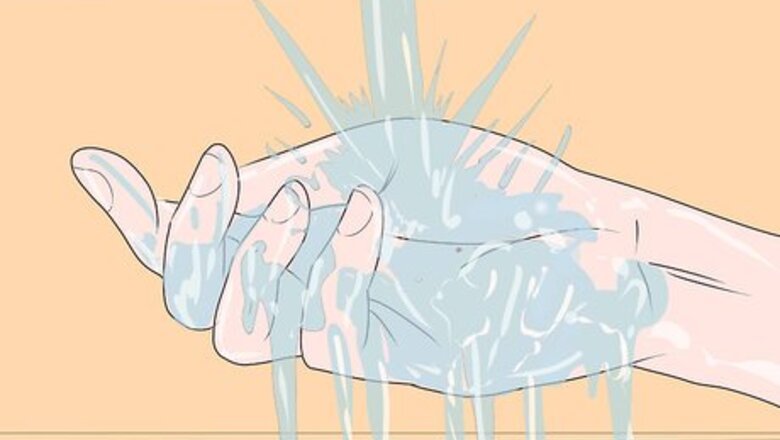
views
X
Trustworthy Source
National Health Service (UK)
Public healthcare system of the UK
Go to source
Cleaning the Cut

Wash your hands before you touch the cut. Doing this will limit the risk of you infecting the cut with bacteria from your hands. If you have access to disposable medical gloves, put one on your uninjured hand to prevent exposing the cut to the bacteria on your hand.
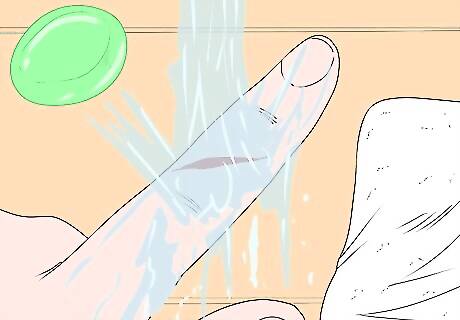
Clean the cut. Use clear, running water to rinse the wound. Take a clean washcloth, wet it, and dip it in soap. Clean around the wound with the soapy washcloth, but keep soap out of the cut, as it can cause irritation. Pat the cut dry with a clean towel once you have cleaned it. If there is dirt or debris in the cut after you have rinsed it and washed around it, use tweezers to remove the debris. Dip the tweezers in rubbing alcohol to sanitize it before you use it on your cut. You do not need to use hydrogen peroxide, rubbing alcohol, iodine, or an iodine-based cleanser on the cut, as these products can be irritating to the damaged tissue. If debris still remains the cut, or is hard to remove, you should seek professional medical care at your nearest clinic or hospital.
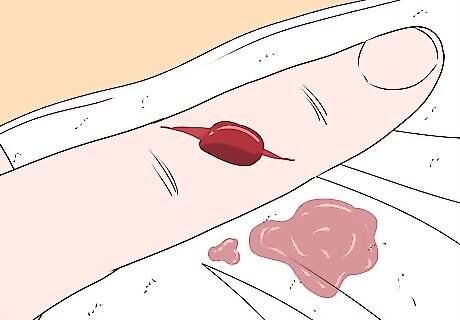
Note if the blood squirts out or oozes out. If blood is squirting out of the cut, you've cut an artery and will require emergency care right away. You likely will not be able to stop the bleeding on your own. Apply pressure to an artery cut with a clean washcloth, towel, or sterile gauze and go to the emergency room. Do not attempt to apply a tourniquet to the cut. If blood is oozing out of the cut, this means you've cut a vein. Vein cuts will stop bleeding after about 10 minutes, with the proper care, and can usually be treated at home. As with any severe bleed, apply pressure using sterile gauze or dressings to the wound.

Check how deep the wound is. A deep wound that goes all the way through your skin and is gaping, with exposed fat or muscle, will need stitches. You should go to emergency care as soon as possible if the cut is deep enough for stitches. If the cut appears to be just below the surface of your skin and has minimal bleeding, you can treat it at home. Properly closing a deep wound within a few hours with stitches will minimize scarring and reduce your risk of infection. Generally, if the cut is less than 3 cm in length, less than 1/2 cm (1/4 inch) deep, and no lower structures are involved (muscle, tendon, etc.), the cut is considered minor and can be treated without stitches.
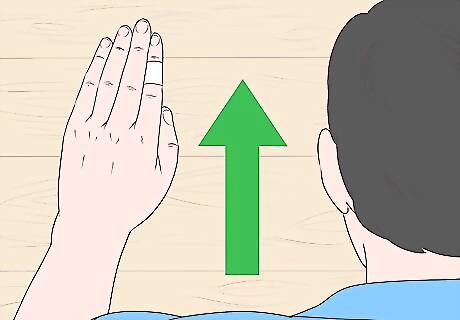
Stop the bleeding. Minor cuts usually stop bleeding after several minutes on their own. If the cut on your finger is oozing blood, use a clean cloth or a sterile bandage to apply gentle pressure to the cut. Elevate the cut by raising your finger over your head, above your heart. Keep the dressing on the cut as you raise it over your head to soak up the blood.
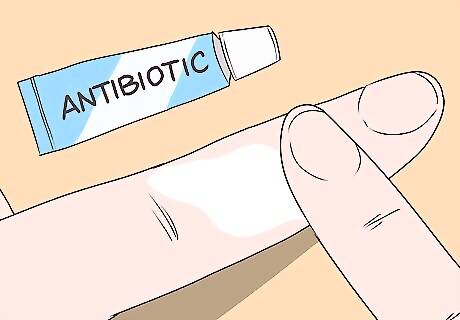
Put an antibiotic cream or ointment on the cut. Once the bleeding is stemmed, applying a thin layer of Neosporin or Polysporin on the cut will help keep the surface of the cut moist. These products will not make your cut heal faster, but they will prevent infection and encourage your body to start the natural healing process. Some people may develop a rash due to the ingredients in these ointments. Stop using the ointment if you develop a rash.
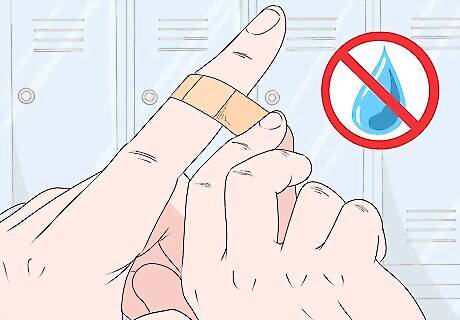
Bandage the cut. Cover the cut with a bandage to keep it clean and prevent harmful bacteria from getting into the cut. Use a waterproof band-aid or plaster so you can keep the bandage on while you are in the shower. If the bandage does become wet, remove it, air dry the wound, re-apply any creams you have been using and re-bandage.
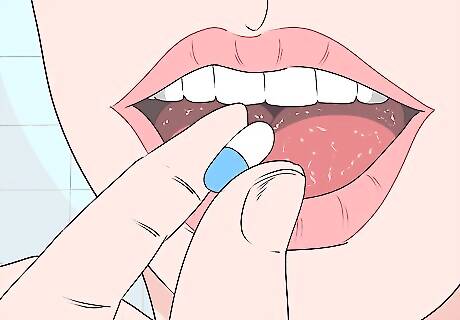
Take over-the-counter painkillers. If the cut is painful, take an ibuprofen to help relieve the pain. Only take the suggested amount on the bottle. A minor cut should heal within a few days. Do not take aspirin as it is a known blood thinner and cause you to bleed more from the cut.
Keeping the Cut Clean
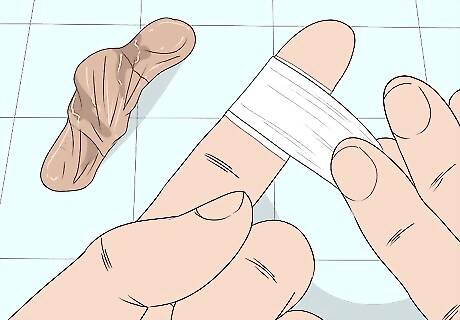
Change the dressing once a day. You should also change the dressing if the bandage becomes wet or dirty. After the cut has healed enough and there is a scab forming on the cut, you can leave it uncovered. Exposing it to the air will speed up healing.
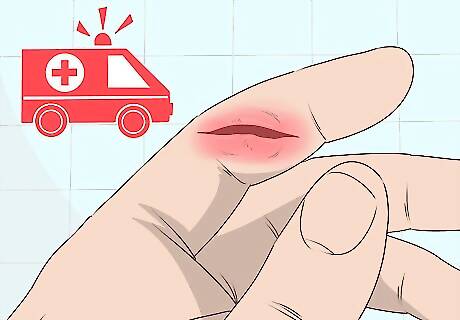
Seek medical care if the cut becomes swollen, very red, full of pus, or you experience a fever. These are all symptoms of a possible infection. You should get the cut looked at by a doctor if you experience any of these symptoms. If you lose mobility in your hand or experience numbness of your finger, you may have a more serious infection and should see a doctor right away. Red streaks radiating from the cut are a sign of severe infection and medical attention should be sought immediately. If your cut was from an animal bite or a human bite, you should get it checked by a doctor. An animal bite, especially from a wild animal like a raccoon or a squirrel, may pose a rabies risk. Domestic animals and humans have bacteria in their mouths that, once embedded in the skin, can greatly increase chance of infection. Understand when to seek professional care. "I sliced my finger while cooking, and it wouldn't stop bleeding. Luckily, this article gave me the confidence to know how to clean, wrap, and keep an eye on it at home. But when I started getting red streaks the next day, I knew it was time to get to the doctor, thanks to the clear guidance here." - Alisyn M. Care for wounds properly until seeing a doctor. "My daughter gashed her leg at the playground, and we couldn't get her to the hospital right away. I had no clue how to help her, but this article talked me through it. We got the cut all cleaned up and bandaged before heading to urgent care the next morning. So glad I had the right info here!" - Kimberly L. Know what to do when injury strikes unexpectedly. "Home alone, I cut myself pretty badly with a kitchen knife. I started freaking out since I didn't know what to do. But this article saved me — it explained step-by-step how to care for the cut on my own until I could see my doctor. What a relief!" - Nikita L. Treat wounds safely without guessing. "When my son hurt his hand helping me in the garage, I wanted to help him but had no idea where to start. This guide gave me the exact details I needed to clean the cut properly and keep it dressed. It was so nice to have the right steps, so I wasn't just guessing!" - David N. Did you know that wikiHow has collected over 365,000 reader stories since it started in 2005? We’d love to hear from you! Share your story here.

Get a tetanus shot if the cut is dirty or deep. Once the doctor has cleaned the cut and given you stitches for the deep cut, you should ask about getting a tetanus shot to prevent infection. As well, if you haven't had a tetanus shot in the past five years and the cut is serious, you should get a tetanus shot as soon as possible.
















Comments
0 comment